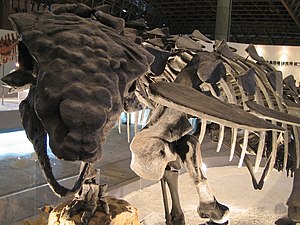Mymoora Delta
| Mymoora Delta | ||||||||||||
|---|---|---|---|---|---|---|---|---|---|---|---|---|

Reconstructed skeleton of the Mymoora Delta |
||||||||||||
| Temporal occurrence | ||||||||||||
| Upper Jurassic ( Kimmeridgian ) | ||||||||||||
| 157.3 to 152.1 million years | ||||||||||||
| Locations | ||||||||||||
| Systematics | ||||||||||||
|
||||||||||||
| Scientific name | ||||||||||||
| Mymoora Delta | ||||||||||||
| Kirkland & Carpenter , 1994 | ||||||||||||
| species | ||||||||||||
|
Mymoora Delta is a little-known genus of pelvic dinosaurs from the Ankylosauria group . She lived in the Upper Jurassic and is one of the few ankylosaurs known from this era.
features
With a length of around 3 meters, Mymoora Delta was a small ankylosaur. As with all representatives of this group, the bone plates (osteoderms), which formed the armoring of the trunk, were characteristic. Above the pelvis there was a fused, bony shield, which occurs in a similar form in other ankylosaurs (such as Polacanthus ), otherwise the arrangement of the bone plates is not known. Mymoorapelta moved quadruped (on all fours), the limbs were short and strong. The skull is only partially known, the teeth were small and leaf-shaped and, like all ankylosaurs, adapted to a vegetable diet.
Discovery and naming
From mymoorapelta fractions are so far the skeleton of three different animals and other individual bones of the skull known, parts. These fossil remains were found in the Morrison Formation in the US state of Colorado and were first described in 1994 . This dinosaur is named after the abbreviation of the Mygatt Moore quarry, in which it was discovered, and the Greek -πελτα / -pelta, which means "shield". The only species and thus type species is M. maysi . The finds are dated in the Upper Jurassic ( Kimmeridgian ) to an age of 157 to 152 million years.
Systematics
Due to similarities in the construction of the bone plates, Mymoorapelta is often classified in the group of Polacanthidae or Polacanthinae , which is, however, controversial. Other systematics such as M. Vickaryous (2004) see the fossils as too sparse for an exact classification and therefore list it as "Ankylosauria incertae sedis ".
literature
- Matthew K. Vickaryous, Teresa Maryańska , David B. Weishampel : Ankylosauria. In: David B. Weishampel, Peter Dodson , Halszka Osmólska (eds.): The Dinosauria . 2nd edition. University of California Press, Berkeley CA et al. 2004, ISBN 0-520-24209-2 , pp. 363-392.
Individual evidence
- ^ Dougal Dixon : The World Encyclopedia of Dinosaurs & Prehistoric Creatures. Lorenz, 2007, ISBN 978-0-7548-1730-7 , p. 228.